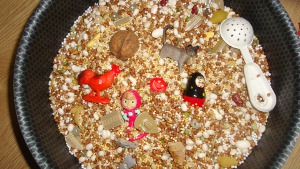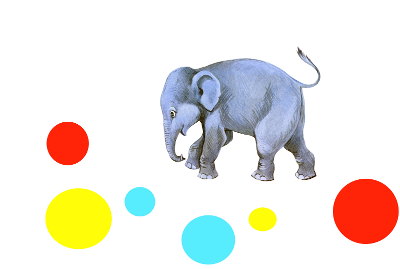Children's developmental programs from 1 year
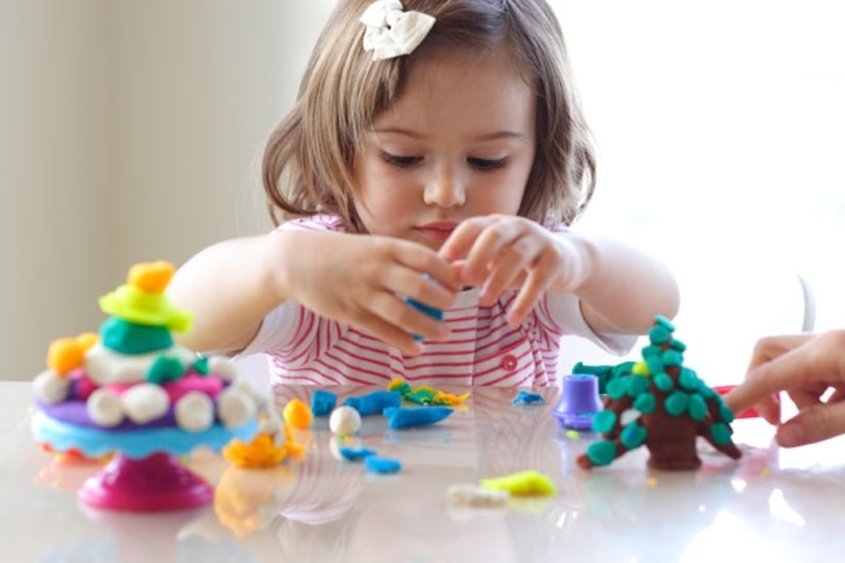
"Gnomes" - comprehensive developmental program, conducted by the teacher early development, Montessori teacher (40 minutes, 2 times a week). Course content includes:
- the inclusion of special exercises in the classroom to stimulate and develop active speech;
- formation of active speech, vocabulary enrichment;
- development of ideas about the shape, size, color, quantity;
- the formation of ideas about the world, man, nature, objects;
- getting to know and playing tales and literary works;
- training in various types of isodating (children do crafts);
- improvement of motor activity (finger exercises, play and dance movements to the music);
- sand play "Wonderful sandbox".
"Wonderful sandbox" - developmental program (included in the complex classes "Gnomes", "Govorun", "Karapuz", "Clever Girl", "Successful student"). With the help of games with sand a child develops:
- fine motor skills;
- tactile sensitivity as the basis of "manual intelligence";
- desire to learn something new, experiment and work independently;
- cognitive functions (perception, attention, speech, memory, thinking);
- the subject-game activity is being improved, which will further contribute to the development of role-playing game and child communication skills.
"Talker" - speech development program (40 minutes, 2 times a week). Spends speech therapist-defectologist, neuropsychologist Zhukova E.V. Course content includes:
- causing speech in non-speaking children using various techniques;
- improving sound pronunciation in poorly speaking children;
- articulation gymnastics;
- expansion of the active and passive dictionary;
- familiarization with the outside world;
- elements of literacy training, the development of auditory attention and phonemic hearing;
- mathematical representations, the development of ideas about the form, size, color, quantity;
- neuropsychological gymnastics, the development of spatial representations;
- phonetic rhythm.
"Fox and tassel" - learning to draw (1 time per week, Sunday). Classes are based on the idea of the game character - the fox, which falls into a variety of game or fabulous situations. The course includes:
- familiarity with the main and additional colors (materials: gouache, watercolor, finger paints);
- familiarity with the application (the use of different-volume paper: corrugated, velvet, cardboard, as well as natural material);
- acquaintance with the skills of small sculptural plastics (modeling from dough, plasticine, coloring products);
- hand setting, fine motor development;
- teaching children to work with a brush, pencil, crayons.
"Logorhythmics" (Once a week). Conducted by a teacher, a music worker. The basis of logorhythmics are speech, music and movement. Musical-rhythmic movements perform a relaxing function, help to achieve emotional discharge, relieve mental overload and fatigue. Logorhythmics is a good helper for speech development. The course includes:
- development of a sense of rhythm, musical ear;
- familiarity with musical instruments;
- phonetic rhythm, speech development;
- learning songs;
- finger exercises, motor development;
- development of spatial coordination of movements;
- general physical development (strengthening of all muscle groups).
Many parents make one big mistake. They buy a child and leave him to deal with them on their own. It is important, however, not just to take the child, but to fully spend time with him playing a game or a child’s developmental activity. For children 1-2 years old it is especially important to feel the presence of mom or dad nearby. Believe me, this makes a significant contribution to it.
Classes for children 1-2 years on the development of cognitive activity and thinking
Picking up a pyramid
- Teaching a child to distinguish colors, shape, size and weight of objects will help exercise with the usual color pyramid. Show your child how to remove the rings from the rod and put them on. Comment on each movement - tell about the color of each ring, its shape and size. Teach to put on the rod first large rings, then small ones.
- If the child can easily cope with the task, in the next step you can complicate it. For this mix rings. Let the baby determine the sequence in which to put them on the rod. Let him name the color of each ring and determine which one is larger and which one is smaller.
Upon completion, be sure to investigate the result. Whether the pyramid turned out smooth or something needs to be fixed? Praise the crumb for good work.
After several such educational activities for children of 1-2 years old, they should learn to distinguish the following colors: black, white, green, red, blue, yellow, and also a round shape.
Building a house of cubes
Ask your baby to build a house for a doll or a bear. Help him in this matter. During the exercise, you can read the corresponding rhymes. They will amuse the crumb and arouse interest in him in everything that happens.
As a result of the activity, the baby must learn the shapes of the cubes. It is clear that the figures are voluminous and square - in this case, rather a cube. But it's too early for the baby to explain. It is enough if he learns how to look like a square, a triangle, a rectangle. During the game, compare items with each other, telling about them to the child. Show how to install the cubes on each other, so that the house does not fall apart.
Educational activities for children 1–2 years of fine motor skills
Plasticine Sculpting
- Draw a tree on a piece of paper. Show your child how to use clay and pinch off small pieces of it. If your child has already learned to distinguish colors, ask what is the color of the apple. Let the baby choose the desired color and stick small apples to the branches of the tree you have drawn. If he still does not distinguish colors, help him with a choice.
- But the second version of the developmental classes for children 1-2 years. Roll out the plasticine sausages together with your child and make a colorful rainbow on the cardboard. Look for the result - "Look, what a beautiful rainbow we have turned out."

Surprise Search
An excellent children's developmental activity for fine motor skills is the search for syuprizik. Pour any cereal into a deep small dish. Suitable millet, rice or buckwheat. Hide small toys (toy soldiers, small pupae, puzzle elements, lego details) or items such as beads, buttons in the rump. Tell the kid a story about someone hiding a treasure and it needs to be found now. Removing the "treasure" will bring the child a real pleasure.
At the end of the article we have prepared for you a check-list "Word games for the development of speech for children from 2 years old." Download a selection of the most interesting games that will develop speech and enrich the vocabulary of the baby.
Surprise can also be wrapped in foil. The main thing is that it is soft and does not hurt the crumbs. The task of the child for 1-2 years in this developmental lesson is to unfold the wrapper and study the subject - to name its shape, color, size, softness, etc.
Drawing
Draw a typewriter. Give the kid a pencil and ask him to draw a path that this machine will take. Let the little one draws kalyaki-malaki. Here the task is to teach him to hold a pencil, to feel the borders of the sheet, to control the movement of the hand.
For girls, you can draw a doll that needs a path for a walk. Options for the occupation of the sea, it all depends on your imagination.
You can draw not only with a pencil, but also use watercolor or finger paints. For such creative activities highlight the baby special clothes, because at first it will be very dirty.
Physical development
In addition to the usual catch-up or hide-and-seek games, additional inventory can be used. For example, take a large ball - fitball, press it against the wall. Take the baby and put it on the ball, hold the crumbs. Let him jump on it under a funny rhyme or song, he sinks his legs, pats his hands.
Development of motor coordination
Zatato classic ball game. Sit opposite each other and roll the ball to each other on the floor. The kid should have time to catch him and roll back to his mother.
In fact, there are a lot of developmental activities for children aged 1-2. If you show imagination, you can come up with your own exercises for the development of the crumbs. The main thing is to take a personal part in this matter. Then the success of the child will quickly make themselves known.
In our previous article we talk about the best.
Download the checklist "Word games for the development of speech for children from 2 years"
Download a selection of the most interesting games that will develop it and enrich the vocabulary of the baby. They can be played anywhere: in transport, in line to the doctor, on the way to kindergarten or shop.
Details
I suggest you to spend together with your baby a developmental lesson for children from 1.5 years to 2 years on the topic "Circle and ball".
Lesson is quite long, if desired, it can be stretched for several days.
1. Musical development.
Let's start our lesson with a musical moment.
Listen to the composition of Zheleznovs "Ball Game" (you can find it here). Making movements in accordance with the words of the song:
Palm beat the ball
Together, fun together.
Ball - ball, my friend,
Voiced, ringing, voiced side.
We beat the ball with the palm of our hand,
Together, fun together.
I throw the ball and catch
I love to play with the ball.
Ball, mommy, do not hide,
I throw the ball back.
I throw the ball and catch
I love to play with the ball.
2. Box with balls - we learn the properties of objects, we develop tactile sensations, we fix the concept of “big - small”:
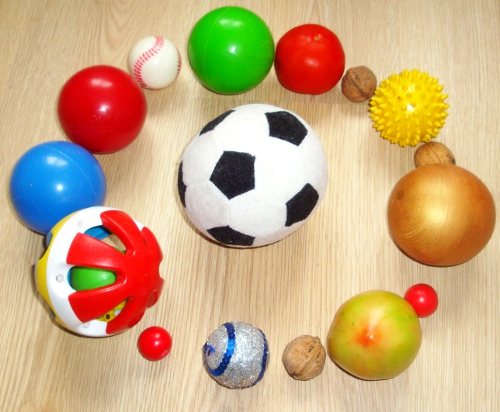 We collect all the ball-shaped items that are in the house (everything is suitable, even what is not intended for children's games: large balls for playing football and small balls for small hands, massage balls, balls of thread, round fruits: oranges, tangerines, nuts : walnuts and woods, real balloons, small round peas, round beads, etc.).
We collect all the ball-shaped items that are in the house (everything is suitable, even what is not intended for children's games: large balls for playing football and small balls for small hands, massage balls, balls of thread, round fruits: oranges, tangerines, nuts : walnuts and woods, real balloons, small round peas, round beads, etc.).
TIP: if there is no suitable number of balls in the house, by analogy you can pick up objects of other shapes, for example, cubes, cars, boxes, etc. In this case, the game can be adapted to the appropriate subject.
We put all the balls in a box or basket (everything fits perfectly in a plastic baby bath).
Stage one - we study the properties of objects:
Considering all the balls with the child and comparing them with each other, it is important to consider and name as many properties of objects as possible, pay attention to the opposite concepts: “Look, this is a big ball, and this is quite small, this one is solid, and this one is soft, and so on. P.).
It would be good if you could pick up the balls so that among them there were balls with such properties: big, small, hard, soft, smooth, rough (rough and soft, for example, there may be a ball of yarn or a ball of paper).
Stage two - we study the concepts of “the biggest, the smallest”:
After all the balls have been researched and announced, we suggest that the child throw one item out of the box: first, the largest, and then descending size:
What is our biggest ball ???? Here he is! Throw it! And now what is the biggest ???? Here he is! Throw it!
It is not scary if the baby does not independently determine which of the balls will be the biggest, even if he does it with his mother - the necessary information in his head will be postponed anyway.
When all the balls have been thrown out of the basket, we begin to fold them back. You can continue the game “find the largest among all the balls”, and you can just learn to throw the balls from a distance into the basket.
 3. "Surprise" - develop fine motor skills.
3. "Surprise" - develop fine motor skills.
Before starting the class, you need to prepare a “surprise” for the child, to wrap in a foil (and if it isn’t there - just paper) different objects.
Since the topic of the lesson is circles and balls - it would be great if we wrapped the balls (different - hard, soft, smooth, etc.). But you can wrap and other items.
We put surprises in a bucket, basket or box and cover them with something (create an element of surprise). It will be much more interesting for a baby to dig up an unknown treasure than if he were just offered to discover all the surprises.
Oh, look what a box! This is probably a bunny left us a surprise! What did he put there ??????????
Show how to open surprises, voice the subject that was in surprise (ball, soft, red, rough, etc.).
For some children, this task may seem rather complicated - it all depends on how developed children's fingers are (and, of course, on how much he likes the game itself). Before the start of the game, evaluate the child’s developmental abilities, it may be worth putting up “surprises” that are not very tightly wrapped (they will be easier to unfold).
4. We are looking for items in the croup - finger massage, motor development, sensory experience.
Put various objects in the croup, show the child that someone hid the treasure in the croup, and have him look for them. Since our occupation is thematic - you can bury spherical or round objects (buttons, beads, nuts) into the rump. You can cut the circles out of cardboard and paint them with bright colors.
5. Application - we develop fingers, we create, we fix the concept "circle", "big-small", we learn colors.
At the age of one to two years, the easiest way to teach a child the name of colors and shapes is to voice the name of the color and shape during the game (red circle, blue circle, etc.) many times.
Cut circles of different sizes and colors. We offer the baby to stick them on paper in any strand. In the course of work, we comment on the color of each figure: “What a beautiful circle you took! He is red, big! Etc."
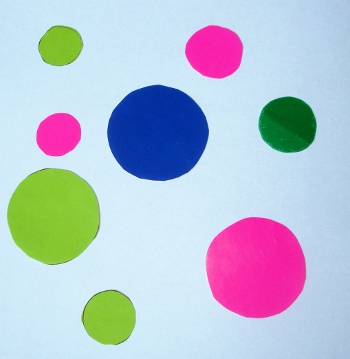
Either the application can be made the plot:
Look, what a baby elephant! He's bored! Let's stick him funny balls so that he can play!
File for printing baby elephant.
An elephant, a kitten, and even just a little man can also be drawn independently.
We offer to perform any of the application options:
Option 1:
This task is for those who still do not know colors very well, and if you want to consolidate knowledge of a certain color. Cut out colored paper circles of two colors (say red and blue). We suggest the child to stick the circles on the paper in any order, we voice it: this is the red circle you are gluing now, and this is the blue one.
Option2:
Cooking circles in two sizes - large and small. We also comment on the work - you now took a big circle, and this is a small one.
Option 3 is more complicated:
Cut out mugs and large and small and different colors. When sticking, we sound - big - small, red, blue, big blue, small red, etc.
Option 4 - the most difficult:
An even more complicated version of such an application is to ask for the figures to be pasted on request:
A) a simple request - "let's paste a yellow circle now";
B) a more complicated request - “find and stick a big yellow circle”.
6. Fun Charging - Playing on a big ball.
 This game is played on a large ball - fitball. But if it is not there - you can hold it and standing on the floor - just by slightly changing the movement:
This game is played on a large ball - fitball. But if it is not there - you can hold it and standing on the floor - just by slightly changing the movement:
We press the ball close to the wall with our knees so that it is well fixed (this is important!).
We put the baby on the ball, hold it by both hands, perform movements under the poem:
Let's jump, jump, jump, (jump)
And we kick up, kick up, kick up,
And handles pat, pat, pat,
And feet we sink, we sink, we sink
Head off
And play again
Repeat the exercise several times in a circle.
A simpler version of the poem:
Girls and boys jump like balls
Handles clap feet stomp,
Eyes blink, after a rest.
7. We learn prepositions.
 Put the ball on the sofa, under the sofa, by the chair, by the chair. We voice our actions to the kid (“look, I put the ball under the chair”). You can try to give the kid a command - “put the ball under the chair, please” (but not all children at this age like to carry out such commands. If the kid just watches how you put the ball over and under - this is enough).
Put the ball on the sofa, under the sofa, by the chair, by the chair. We voice our actions to the kid (“look, I put the ball under the chair”). You can try to give the kid a command - “put the ball under the chair, please” (but not all children at this age like to carry out such commands. If the kid just watches how you put the ball over and under - this is enough).
In order for the lesson to be more playful, the ball can be placed on the table and under the table by a bear cub or a hare (soft toy).
8. Learn to roll the ball.
This is a classic exercise that develops coordination of movements. Mom and baby sit opposite each other and roll the ball to each other on the floor.
For this game you can use these verses:
Across the sky the sun goes
And in the houses comes.
And to Tanya comes (roll the ball to the baby),
And to mother comes (the kid rolls a ball back),
And to Tanya comes,
And comes to mom ...
My funny ringing ball
9. Expand vocabulary.
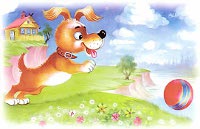 In conclusion, I suggest reading together with the child the wonderful poems by S. Marshak "My cheerful sonorous ball."
In conclusion, I suggest reading together with the child the wonderful poems by S. Marshak "My cheerful sonorous ball."
- Riddles for girls on 8
- When on the ship two flags
- Order on the creation of the duty dispatch service
- Historical flags of the states of 1700
- The role-playing game as the main type of games for preschoolers place in the structure of children's games
- Logic Tricks for Adults
- Medical Institute with budget places

 Live journal
Live journal Facebook
Facebook Twitter
Twitter